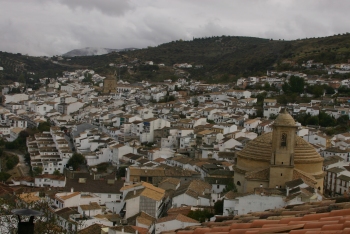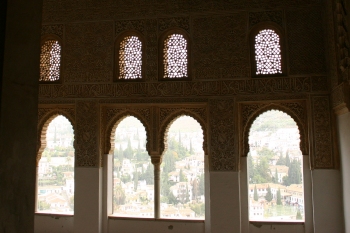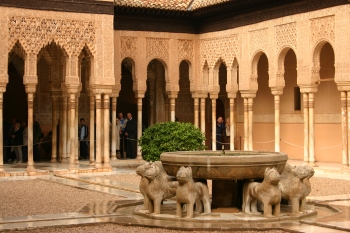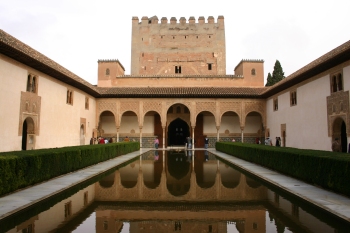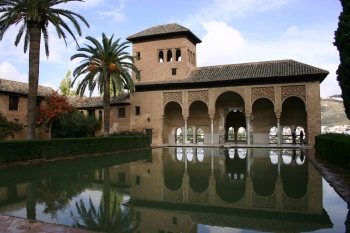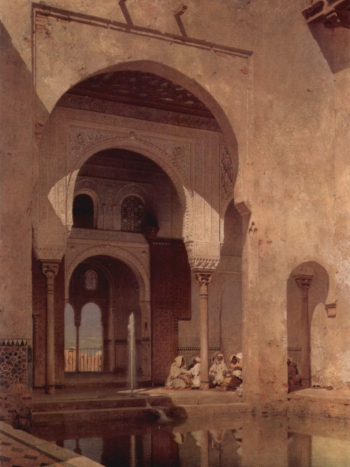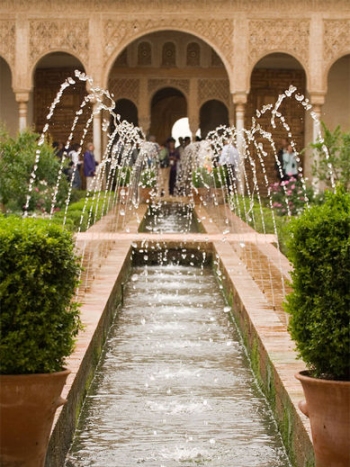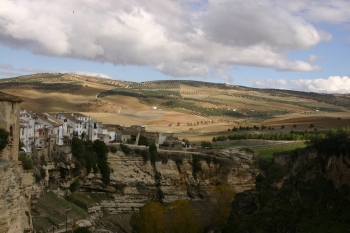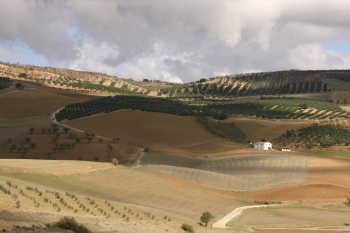10 December 2006
Penny & Greg's Spanish Siesta - Part 4
Granada and the Alhambra
So, we set off from Cordoba at some point in the morning and, again, took the smaller roads toward Granada. Rolling countryside and olive groves predominant throughout this part of Andalusía, it would seem – very pretty. About 11.00 or so we arrived at a town called Montefrio which is described as the archetypal Andalusían town and which is very pretty indeed, fabulous views of tiled rooftops and white-washed houses which run up to a steep crag on top of which is perched some Moorish fortifications. Naturally, the Christians erected a church on top of the Moorish stronghold to demonstrate their dominance. As we climbed toward the church on the top of the hill we were surprised to see a Calle de Washington Irving – i.e., Washington Irving Street. I had not known that he was especially well-known in this part of Spain nor, indeed, that he had any connection with the country. However, we were to discover that he had indeed travelled all over Andalusía and, in particular, wrote about the Alhambra in Granada in a book published in about 1832 – Tales of the Alhambra. It seems that he was American ambassador to Spain during the administration of Martin Van Buren and, in between fulfilling his official functions, travelled throughout the country and ended up staying in the Alhambra for about three months.
We had lunch in Montefrio at a relatively quiet café/bar and were struck by the fact that Spanish men clearly have no work to do; the country is obviously run by the women (which, when you think about it, is probably true for most countries). Everywhere we turned there was considerable evidence of a considerable amount of work being undertaken but nowhere did you ever see anyone doing any of the work. In the bars and cafés there always seems to be a number of men sitting drinking some beer or wine and smoking endless cigarettes (or rather, endlessly smoking cigarettes; the cigarettes themselves were not, of course, endless); at ten in the morning, noon, two in the afternoon and in the early evening – the men are drinking while the women, presumably, are at home looking after the children, washing, fixing a meal, etc. We discussed this phenomenon for some time and finally Pen came up with the suggestion that most of the men in this area (and certainly those propping up the bar at noon in Montefrio) were perhaps olive farmers (which makes sense considering that all one sees are olive groves). Olive growing is very probably an occupation which requires extensive labour at certain times of the year and, apparently, not in early November when we were there. Clearly at harvest time the olives require some labour and attention and also, I guess, at some stage during the year when the weeds have to be kept at bay, trees need pruning and new ones planted and so on. The rest of the time, however, the men have nothing better to do than to stand shoulder to shoulder at the bar, drink beer and/or wine, eat some tapas and presumably put the world to rights. Hmmm, not bad, I suppose. And, while this explains the absence of labourers in the fields, it doesn't really explain the absence of any workmen at any of the multitude of civic projects we came across – lots of torn up streets with significant amounts of work to be carried out and no one seemingly doing anything. Oh well, there's always mañana. So, after a pleasant drink and a bite to eat in Montefrio it was back on the road towards Granada which we reached in the late afternoon. We found a very pleasant hotel literally just across the road from the Alhambra and, after some confusion with the check-in girl as to whether we wanted the deluxe accommodation (complete with ensuite spa) we were checked in to a “normal” room which was most assuredly very comfortably pleasant. As it was late afternoon we decided to spend the rest of the afternoon and evening wandering through the Albaicín, the old Moorish part of the town nestling just beneath the Alhambra. Here we wandered through narrow, winding, cobbled alleys cluttered, not surprisingly, with lots of tourist shops but also numerous bars and cafés with a decidedly Moorish feel. Indeed, this was the most Moorish of all the places we had visited thus far and very pretty indeed. After several vino tintos in a number of establishments, we wandered back to the hotel for dinner and an early night preparing ourselves for the big one, the Alhambra itself.
The following morning, we rose at leisure and had a bite of breakfast before making our way across to the Alhambra. Apparently, in the height of the tourist season one has to book one's entrance to the Alhambra months in advance – they only allow something like 7000 people in each day. However, we were able to walk straight up to the counter and purchase our tickets for the morning session without delay. Essentially, there are two slots per day; 8.00 until 2.00 in the afternoon and then 2.00 in the afternoon until 8.00 at night and one is supposed to stick to one's session. I guess it might be a bit more crucial in the busy season but clearly wasn't essential at this time of year. After getting our tickets we queued for a minute or two at the desk distributing the audio guides and then set out on our explorations by about 10.00. The only other restriction they make is that you are given a half-hour window during which you must enter the Nasrid palace itself; once you have entered you can stay as long as you like. So, we made our way to the entrance and, by the time we had finished about 3.00 in the afternoon, we had walked several dozen miles and climbed several thousand steps. In spite of the effort involved, however, one has to say that this is the big one! Simply stunning! (Oops – amazing, dramatic, eye-catching, dazzling, spectacular, astonishing, striking, etc., etc., etc.) The only comment one has to make is that the Spaniards, once again, ruined it by plonking the Palace of King Charles V right in the middle of it. The palace is heavy and stolid, nothing like the grace, light and freshness of the Muslim palace.
Although there was a fortification on the site of the Alhambra, the Nasrid palace wasn't begun until the middle part of the 13th century. Construction continued into the 14th century and the magnificence of the place is partly due to their desire to belie an image of waning power. They used modest materials (tiles, plaster and timber) but worked them in an unbelievably elaborate manner (and “elaborate” doesn't really begin to do it justice). The plasterwork in particular is just stunning (substitute favourite synonym). Both Pen and I did think of Dad and Mom on one occasion – in one room which had, at one time, enjoyed a glorious view across the old town, King Charles's palace was plonked right in the way, spoiling the view forever. As you would expect, there are fountains and water everywhere and lovely courtyards. While we enjoyed wonderfully temperate conditions, I guess the water, gardens and courtyards were essential elements in making the place tolerable during the oppressive conditions endured for much of the year.
After spending several hours wandering around the Alhambra, we made our way up the hill to the Generalife, the private gardens of the sultan. Here the buildings are considerably plainer – no one of any importance ever was allowed up here; all the important diplomatic and official work took place in the Alhambra, particularly in the Salón de Embajadores – the Hall of the Ambassadors (which is where Columbus,apparently, was given the go-ahead for his voyage to the Indies by Ferdinand and Isabella). The Generalife has wonderful gardens, however, again with lots of fountains and trickling water. Finally, after another hour or so we made our way back down to the Alhambra and bought a copy of Washington Irving's “Tales of the Alhambra” which, once one gets over the somewhat flowery language, is very entertaining. A quick lie down in the hotel before another wander around the Albaicín and dinner at an Arab restaurant we had espied the night before – delicious.
And so, our Spanish siesta was very nearly at an end. The following morning we departed Granada enroute, again via the smaller roads (and, on one occasion, a dirt road which we were convinced was going to give out in the middle of nowhere) to Malaga and our flight to Geneva that evening. The scenery was, once again, fabulous, and we made our way to Alhama de Granda along the way. This place is incredible, a charming little town balanced on the edge of a precipitous gorge surrounded by lush, fertile land (just about the only area we saw anything other than olive groves was along the bottom of the valley as we made our way toward Malaga). So there you have it – Penny and Greg's Spanish Siesta. A great trip full of wonderful sights. Although it was pure luck, I am glad we did it in the order in which we did; each place was even more impressive than the previous and to finish it off with the Alhambra was simply wonderful. Stunning. Some additional photographs from Granada Back to the Befouled Weakly News Index Back to Greg's Temporary Home Page
|
